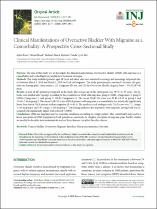| dc.contributor.author | Başer, Aykut | |
| dc.contributor.author | Eliaçık, Sinan | |
| dc.contributor.author | Baykam, Mehmet Murat | |
| dc.contributor.author | Uysal Tan, Funda | |
| dc.date.accessioned | 2021-11-01T15:03:04Z | |
| dc.date.available | 2021-11-01T15:03:04Z | |
| dc.date.issued | 2020 | |
| dc.identifier.citation | Baser, A., Eliaçık, S., Baykam, M. M., & Tan, F. U. (2020). Clinical manifestations of overactive bladder with migraine as a comorbidity: a prospective cross-sectional study. International Neurourology Journal, 24(4), 375. | en_US |
| dc.identifier.issn | 2093-4777 | |
| dc.identifier.issn | 2093-6931 | |
| dc.identifier.uri | https://doi.org/10.5213/inj.2040186.093 | |
| dc.identifier.uri | https://hdl.handle.net/11491/6953 | |
| dc.description.abstract | Purpose: The aim of this study was to investigate the clinical manifestations of overactive bladder (OAB) with migraine as a comorbidity and to shed light on possible new treatment. strategies. Methods: This study included patients aged 18 years and older who were admitted to urology and neurology outpatient clinics between March 1, 2019 and March 1, 2020 for OAB and migraine. The study questionnaire contained 3 sections: (1) questions on demographic characteristics, (2) a migraine II) test, and (3) the Overactive Bladder Inquiry Form - V8 (OAB-V8) form. Results: A total of 265 patients participated in the study. The average age of the participants was 39.75 +/- 11.93 years. The patients were divided into 3 groups according to the coexistence of OAB with migraine: group 1, OAB(+)/migraine(+); group 2, OAB(+)/migraine(-); and group 3, OAB(-)/migraine(+). The mean OAB-V8 score was 22.82 +/- 8.15 in group 1 and 25.64 +/- 7.49 in group 2. The mean OAB-V8 score of OAB patients with migraine as a comorbidity was statistically significantly lower than that of OAB patients without migraine (P = 0.015). The median visual analogue scale (VAS) score was 7.11 (range, 2-10) in group 1 and 5.95 (range, 2-10) in group 3. This finding indicates that in patients with migraine, having OAB was associated with significantly higher VAS scores (P <0.001). Conclusions: OAB and migraine may be comorbid conditions coexisting in a single patient. This comorbidity may lead to a lower perception of OAB symptoms in OAB patients or, conversely, to a higher perception of migraine pain. Further studies are needed to elucidate how treatments for each of these diseases can affect the other disease. | en_US |
| dc.language.iso | eng | en_US |
| dc.publisher | Korean Continence Soc | en_US |
| dc.relation.ispartof | International Neurourology Journal | en_US |
| dc.rights | info:eu-repo/semantics/openAccess | en_US |
| dc.subject | Urinary bladder | en_US |
| dc.subject | Overactive | en_US |
| dc.subject | Migraine disorders | en_US |
| dc.subject | Urinary incontinence | en_US |
| dc.subject | Nocturia | en_US |
| dc.title | Clinical Manifestations of Overactive Bladder With Migraine as a Comorbidity: A Prospective Cross-Sectional Study | en_US |
| dc.type | article | en_US |
| dc.department | Hitit Üniversitesi, Tıp Fakültesi, Cerrahi Tıp Bilimleri Bölümü | en_US |
| dc.department | Hitit Üniversitesi, Tıp Fakültesi, Dahili Tıp Bilimleri Bölümü | en_US |
| dc.identifier.volume | 24 | en_US |
| dc.identifier.issue | 4 | en_US |
| dc.identifier.startpage | 375 | en_US |
| dc.identifier.endpage | 381 | en_US |
| dc.relation.publicationcategory | Makale - Uluslararası Hakemli Dergi - Kurum Öğretim Elemanı | en_US |
| dc.department-temp | [Baser, Aykut; Baykam, Mehmet Murat] Hitit Univ, Dept Urol, Sch Med, Corum, Turkey; [Eliacik, Sinan; Tan, Funda Uysal] Hitit Univ, Dept Neurol, Sch Med, Corum, Turkey | en_US |
| dc.contributor.institutionauthor | Başer, Aykut | |
| dc.contributor.institutionauthor | Eliaçık, Sinan | |
| dc.contributor.institutionauthor | Baykam, Mehmet Murat | |
| dc.contributor.institutionauthor | Uysal Tan, Funda | |
| dc.identifier.doi | 10.5213/inj.2040186.093 | |
| dc.description.wospublicationid | WOS:000604618400010 | en_US |
| dc.description.scopuspublicationid | 2-s2.0-85100080362 | en_US |
| dc.description.pubmedpublicationid | PubMed: 33401359 | en_US |


















